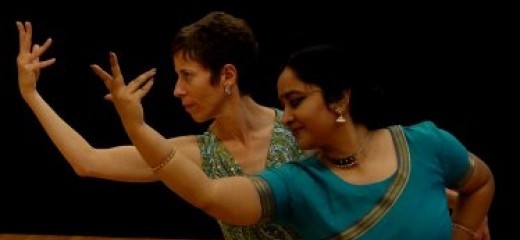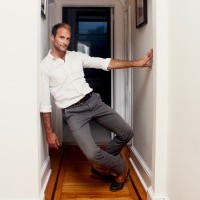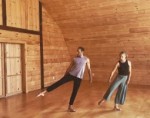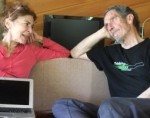
photo: Penn State University
Breaking, Beats, and Cross-Rhythms
by Beau Hancock
Vanetta Wood, in blue jeans and t-shirt, casually steps to the Performance Garage stage. She lifts her toes to tap out a beat (1, 2, 3, 4), then launches into a concise series of subtle shuffles, hops, taps and slides, her
Intro: Beats preparing the audience for an evening of rhythmic complexity.
Cross-Rhythms, the program’s title, is all about the primacy of the beat. From Suparna Banerjee and Michele Dunleavy’s blend of Bharathanatyam and tap dancing to hoofer Darrell Williams’ and vocalist Aleasha Freeman’s sentimental coupling in Something in your Eyes//From Word to Sound, each of the nine works shares a common interest in dancing on and around the beat.
Banerjee and Dunleavy’s Fractals confronts the beat through iteration, a multiplying of rhythmic forms. Banerjee’s ghungroo, or dancing bells, shape the structure with each stamp of her foot as Dunleavy’s high-heeled tap shoes provide a contrasting tone, all layered with Jean Theileman’s Bluesette played by a local jazz trio. Their dancing weaves in and out of harmony, creating intricate polyrhythms, an arrangement that is far more dynamic than its constituent parts. A single clap phrase from Banerjee leads to a variation on that theme by Dunleavy. A call and response dialogue is created, a conversation in taps and stamps that builds throughout the work.
In Violet’s Dream, Pamela Hetherington, with a toothy smile and legs for days, blends delicate dancing with an arrangement of Jerome Kern and Dorothy Field’s The Way You Look Tonight. Dena Underwood’s smooth vocals pair with Hetherington’s caressing taps, like a mother’s soothing touch.
“The break is an unexpected, uncontrollable space,” Germaine Ingram’s amplified voice chants in Breaking this…: an improvisation on the genius of Thomas DeFrantz. “It contains both the tie to a ubiquitous rhythmic flow and the potential for anarchy and disruption.” This recorded quote (from an article by DeFrantz) repeats in the background. Ingram and Leah Stein travel a linear pass across the stage, their idiosyncratic gestures forming a pulse of stops and starts. Ingram pounds the floor; Stein mimics this rhythm with an elbow. Ingram calls out, “breaking,” which is echoed by Stein in a stuttering, jagged pattern, “brea, brea, breaking”. This making in the moment is not winging it, but two masters of movement developing a fully formed idea in front of an audience.
Heather Cornell’s Scrapple from the Apple, a 1986 work for Manhattan Tap, was restaged on Dunleavy, Hetherington, Becky Mastin and Katie Delhagen. With an arrangement of Charlie Parker’s score, Scrapple is a demanding piece, with moments of precise unison and daring solos. The latter provide a chance for the quartet of dancers to “one-up” each other’s skills. Dunleavy is particularly at ease in this work, her split-second timing and responsive torso lent the challenging steps a casual air.
Excerpts from Gold directed by Keila Cordova and featuring Theresa Pelicata as a tapping starlet brings to mind the Golden Age of Hollywood musicals, a Busby Berkley-esque spectacle, complete with Pelicata dancing on enlarged silver dollar set pieces. The “Excerpts” from the title might explain why this section contrasts wildly with the first: a quartet of female modern dancers indulgently rolling, diving, and sweeping across the stage. And while the quartet emerges as Pelicata’s chorus, the bearers of her silver dollars, the shift in register from breath-phrased modern to flashy Broadway tap feels jarring.
“How are you tonight,” Darrell Williams asks the audience, tapping from foot to foot in the second half of his Something in your Eyes. He follows with gentle scuffs, sly syncopations, and pyrotechnic rolls. Williams invites the trio of musicians on-stage. A whispered conversation, a song chosen. Williams and the saxophonist Jon Katz alternate riffing on the melody of a jazz standard. This improvised exchange is one of the most alive of the evening, filled with the uncertainty of “Can Williams pull this off?” He does. His cool presence and facility makes the muddy transition (from the first section) and awkward pause (for the band to get set up) ultimately trivial.
Clad in matching outfits of vibrant red and blue, Banerjee and Dunleavy return for Take Five, using the lighthearted, joyful undulations of the Paul Desmond score to create a unified counterpoint. The synthesis of music and dance is far more apparent here than in the polyphony of Fractals. Even more striking than the musical relationship is how the dancers interact, at times acknowledging the musicians or audience, but generally focusing on each other, mirroring specific gestures or passing the beat. At one point Banerjee raises her left leg in front, her right arm overhead, her left arm curved forward in what is recognizably a posture from Bharatanatyam. Dunleavy replicates this stance, but her variant is softer, less shape-oriented, with a look that asks, “Did I get this right?” Their camaraderie throughout Take Five feels important, as though saying that our different methods of moving (or speaking, or thinking) should bring us together.
Outro:Beats from Wood is another brief but compelling creation, her tapping more subdued, less dramatic, her restrained beats preparing the audience to exit this space of thoughtful rhythms, a momentary break from the cacophony of the city streets outside.
Cross-Rhythms, Performance Garage, June 8.
By Beau Hancock
June 18, 2012







.png)


